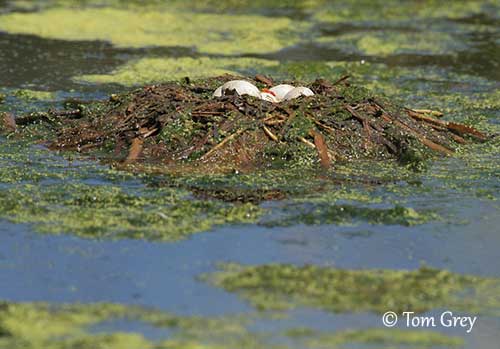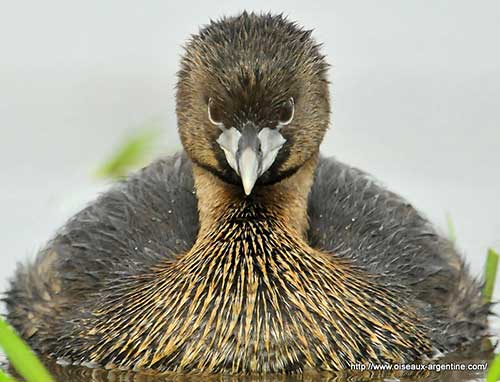
Fr: Grèbe à bec bigarré
Ang: Pied-billed Grebe
All: Bindentaucher
Esp: Zampullín Picogrueso
Ita: Podilimbo
Nd: Dikbekfuut
Sd: tjocknäbbad dopping
Photographers:
Roger Ahlman
Pbase Galleries Peru and Ecuador
Jean Michel Fenerole
Photos d’Oiseaux du monde
Eduardo Andrés Jordan
MIS AVES – AVES DE ARGENTINA
Tom Merigan
Tom Merigan’s Photo Galleries
Tom Grey
Tom Grey's Bird Pictures
Philippe and Aline Wolfer
OISEAUX D'ARGENTINE
Text by Nicole Bouglouan
Sources:
HANDBOOK OF THE BIRDS OF THE WORLD vol 1 by Josep del Hoyo-Andrew Elliot-Jordi Sargatal - Lynx Edicions - ISBN: 8487334105
Bird Web (Seattle Audubon Society)
Animal Diversity Web (University of Michigan Museum of Zoology)
Pied-billed Grebe, Podilymbus podiceps
Wikipedia, the free encyclopaedia
Pied-billed Grebe
Podilymbus podiceps
Podicipediformes Order – Podicipedidae Family
INTRODUCTION:
The Pied-billed Grebe of genus Podilymbus is today the sole member of this group, following the extinction of the Atitlan Grebe, the second member of this genus.
The Pied-billed Grebe is restricted to the Americas, from Alaskan coasts, Canada and USA, through some Caribbean islands and S to South America. The northern populations are migratory.
It is often solitary and less sociable than other grebes. Rarely seen in flight and secretive while breeding, it is nevertheless very territorial during the nesting period.
This species feeds on a variety of aquatic prey including small fish, crustaceans and insects.
The nest is a floating structure anchored to aquatic plants in shallow water, and both adults share the nest-building and the nesting duties.
The Pied-billed Grebe is threatened by degradation and destruction of wetlands, poisoning, accidental shooting and egg-collection. The population trend is generally stable and the species is not globally threatened.

DESCRIPTION OF THE BIRD:
Biometrics:
Length: 30-38 cm
Wingspan: 45-62 cm
Weight: 339-458 g
The Pied-billed Grebe in breeding plumage has dark brownish upperparts with rather greyish-buff neck sides and flanks. We can see a conspicuous black patch on chin and throat with whitish outlining. The black patch is sharper in males, with the black extending up to the malar area. The short tail is pointed.
On the underparts, lower breast, belly and underwing are pale buffy-white, but the undertail-coverts are white.
The head is dark brownish with paler head sides.
The short, thick bill is laterally compressed with decurved tip forming a slight hook. It is bluish-white with conspicuous black vertical bar. The eyes are dark brown surrounded by bluish-white eyering and lores are similar. Legs and lobbed feet are blue-grey.
Male and female are similar, but the male is larger overall, with heavier bill.
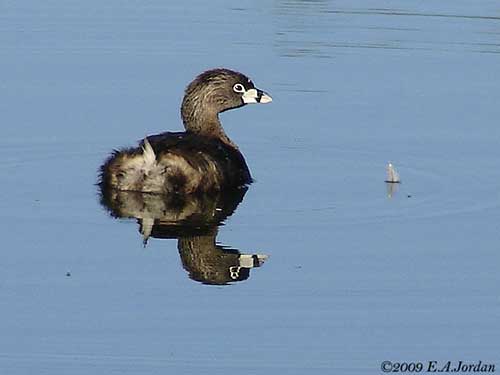
The non-breeding adult has pale throat. The upperparts are like in breeding plumage, but neck sides and flanks are reddish-brown. The bill is mostly flesh-coloured, without black markings, although some individuals may show a more or less faded black band in winter.
The juvenile resembles non-breeding adult, but there are some dark brown and white markings on head sides, usually until late winter.
The bill is dull orange-red, but it lacks the black bar. The cutting edges of both mandibles are black.
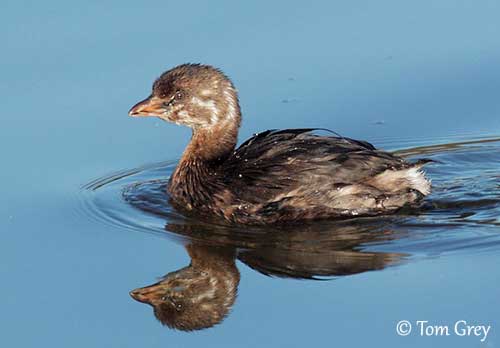
SUBSPECIES AND RANGE:
The Pied-billed Grebe has three subspecies.
P.p. antillarum is found in Greater and Lesser Antilles.
P.p. podiceps (described above) is found in S and C Canada S to Panama. It winters in S USA, C America and West Indies.
P.p. antarcticus is found in S America, from E Panama, S to SC Chile and SC Argentina.
This race is larger, but all races are very similar overall.

HABITAT:
The Pied-billed Grebe breeds in freshwater ponds and lakes, often shallow, stagnant fresh waters and slow-flowing stretches of rivers. It is less present in brackish waters. Emergent or aquatic vegetation is required for nesting.
During winter, it also frequents wet habitats, as long as the water is not frozen.
This species often breeds up to 3,100 metres of elevation in E Andes of Colombia.
On migration and outside breeding season, it can be found on more open waters, including estuaries and coastal bays, and brackish coastal waters.
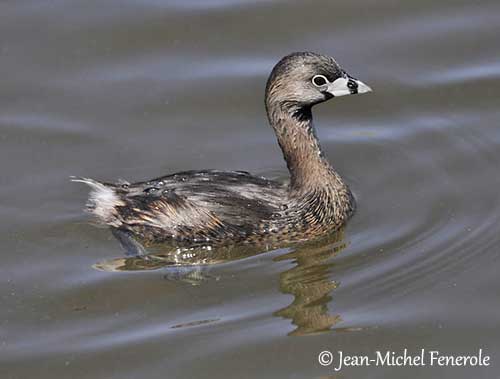
CALLS AND SONGS: SOUNDS BY XENO-CANTO
The Pied-billed Grebe gives series of hollow notes “cow-cow-cow-cow-cow-cow, cowp, cowp, cowp” slowing down towards the end.
During courtship and territorial behaviour, both adults use vocalizations and visual displays to communicate. A pair may perform duets during courtship.
The song varies from series of “wup-whut, kuk” calls continually increasing, to a “cow” followed by high-pitched “kuk” and lower-pitched “kow”.
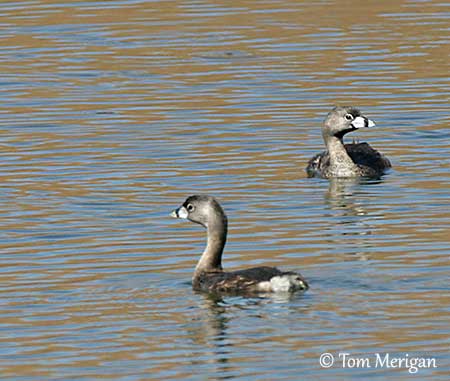
BEHAVIOUR IN THE WILD:
The Pied-billed Grebe feeds on small fish and crustaceans, especially crayfish, and also aquatic insects and their larvae. But the diet varies with seasons and locations. However, molluscs, frogs, tadpoles, salamanders, spiders and some aquatic plants are also part of the diet.
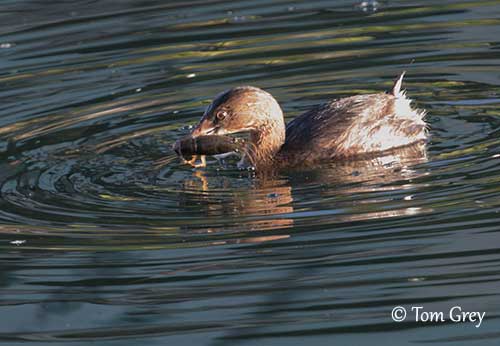
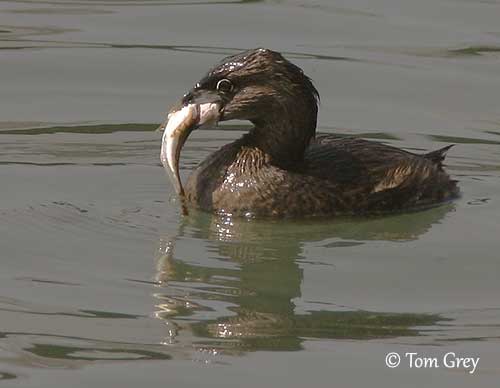
Like other grebe species, the Pied-billed Grebe eats many feathers, sometimes in large quantities, and feathers are also given to the young, especially to the chicks right from the day they hatch.
This habit is especially common in the fish-eating species, probably to clean the remaining fish bones. The feathers are mixed with the food and form pellets that are regurgitated periodically.
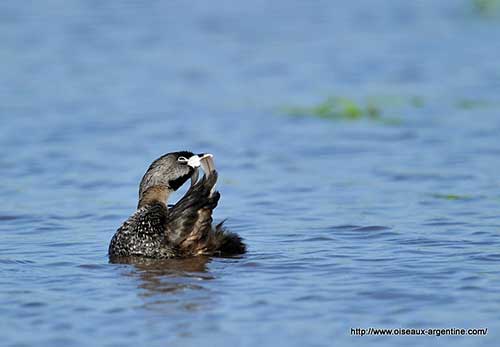
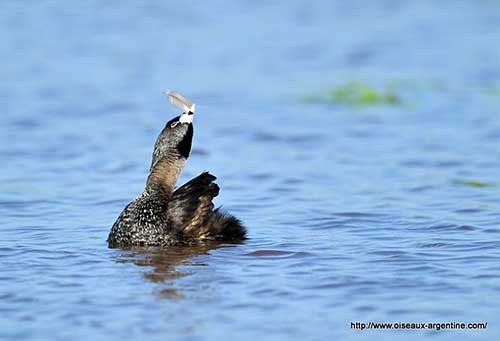
The Pied-billed Grebe forages by diving from water surface. It also swims underwater, propelled mainly by its lobbed feet. It usually dives to 1-4 metres below the surface.
The Pied-billed Grebe is seasonally monogamous or over several seasons. The courtship displays are usually less ritualized than in other grebe species, and involve much calling and duets by pairs.
Both mates often swim parallel with body feathers sleek and bill slightly open. Greeting calls are given by one or both birds.
Some other displays are described, involving an upright posture accompanied by a greeting call, followed by turning movements of the head.
Another display shows the mates circling around each other in a stooped position. They also dive and race underwater to show their swimming prowess.
They nest in a floating structure anchored to marsh vegetation.
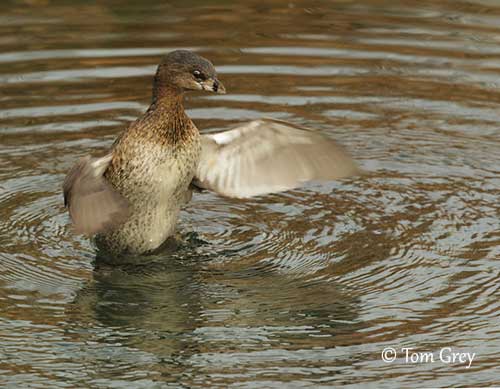
The Pied-billed Grebe is mainly sedentary, but the populations of the northern parts of the range move southwards and winter in Baja California and Central America. The South American populations are sedentary.
They move alone or in pairs, mainly by night.
Like other grebes, the Pied-billed Grebe needs a long running start on water surface while flapping very quickly the wings in order to take off. It is s a strong flier but it has to keep beating its wings quickly throughout the flight, because the wing-loading is fairly heavy. It does not often, but it is able to travel long distances.
However, if threatened, grebes usually prefer to dive rather than take off.
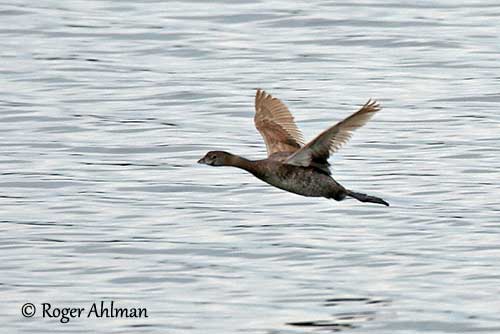
REPRODUCTION OF THIS SPECIES:
The breeding season takes place between May and September in North, from September to December in South, and all year round in tropical areas.
The nest-site is usually in shallow water in marsh. Both adults build the nest, a structure made with aquatic vegetation including soft, flexible decomposed or fresh plants found at the bottom. This structure is floating or built up from the bottom, and anchored to reeds, rushes or bushes. It resembles a bowl.
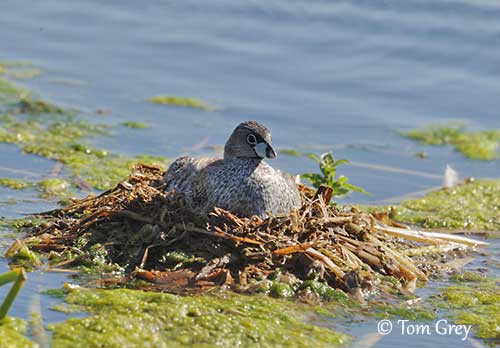
The female lays 4-7 (rarely 2-10) pale bluish-white eggs that become stained and brownish as the incubation is in progress. Both adults, but mainly the female, incubate during 23 days (23-27 days). When the incubating bird leaves the nest, it covers the eggs with nest materials.

At hatching, the chicks have black down with white stripes and the underparts are paler. They are fed by both parents and often ride on adult’s backs when still small. The adults can even swim underwater while the young is on their back.
The chicks leave the nest just after hatching, usually within an hour. They fledge 35 days after hatching, and become independent within 25-62 days.
The Pied-billed Grebe produces a single brood per year, although two broods can be raised in the southern parts of the range.
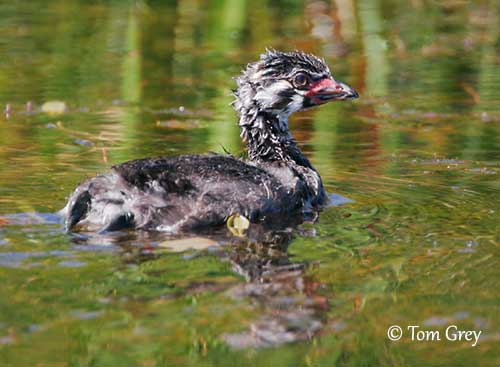
PROTECTION / THREATS / STATUS:
The Pied-billed Grebe has very large range in the Americas, and the species is described as relatively common.
It is threatened by degradation of wetlands involving destruction of the habitat. Poisoning from pesticides, accidental shooting, entanglement in fishing lines and egg-collection may also affect this species.
The overall population trend is stable, and a small, insignificant increase is suspected in North America.
The Pied-billed Grebe is not considered globally threatened, and currently evaluated as Least Concern.
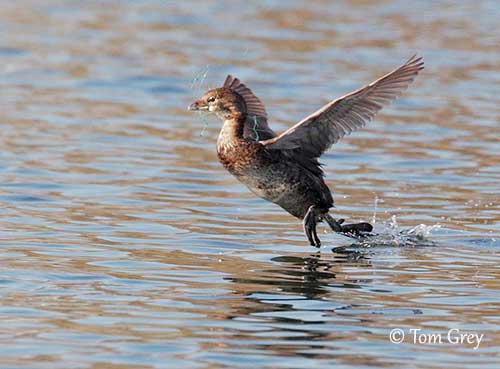
Photographer’s comment:
I noticed that the bird was entangled in filament only when I processed the image; after posting it on a local birding site, I learned the bird had been seen earlier and had survived for months in this condition.
